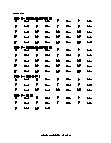Binomial Probability Worksheets
What Is Binomial Probability? Binomial probability refers to the possibility of 'x' successes on 'n' numerous trials in an experiment that has two possible outcomes, generally called a binomial experiment. The binomial distribution formula: b (x; n, P). Where b = binomial probability. x = total number of "successes." In the probability theory and its statistics, the binomial circulation with strictures 'n' and 'p' is the distinct probability distribution of the number of victories in a sequence of 'n' independent trials, each asking a yes or no question, and each with its Boolean-valued result. The binomial distribution is commonly used to model the number of accomplishments in a sample of size ‘n’ drawn with replacement from a population of size N. If the sample is carried out without spare, the draws are not independent, and so the resulting distribution is hypergeometric, not a binomial one. However, for N much bigger than n, the binomial distribution remains a good estimate and is extensively used. This approximation is a huge time-saver when undertaking calculations by hand; factually, it was the first use of the normal delivery, in 1738. These days, it can be seen as a consequence of the central limit theorem. This fact is the basis of a hypothesis test, a "proportion z-test", for the value of p using x/n, the sample proportion and estimator of p, in a common test statistic. For example, suppose one randomly sample n people out of a large population and ask them whether they agree with a certain statement. The proportion of people who agree will of course depend on the sample. If groups of n people were sampled repeatedly and truly randomly, the proportions would follow an approximate normal distribution with mean equal to the true proportion p of agreement in the population and with standard deviation.
-
Basic Lesson
Guides students solving equations that involve Binomial Probability. Demonstrates answer checking. A test consists of 10 multiple choice questions with five choices for each question. As an experiment, you GUESS on each and every answer without even reading the questions. What is the probability of getting exactly 6 questions correct on this test?
View worksheet -
Intermediate Lesson
Demonstrates how to solve more difficult problems. A family consists of 3 children. What is the probability that at most 2 of the children are boys?
View worksheet -
Independent Practice 1
A really great activity for allowing students to understand the concept we are working on here. The probability that Kyla will score above 80 on a mathematics test is 2/5. What is the probability that she will score above 80 on exactly two of the three tests this quarter?
View worksheet -
Independent Practice 2
Students find the Binomial Probability in assorted problems. The answers can be found below. The probability that Kyla will score above a 40 on a mathematics test is 2/5. What is the probability that she will score above a 40 on exactly four of the seven tests this quarter?
View worksheet -
Homework Worksheet
Students are provided with problems to achieve the concepts of Binomial Probability. The probability that Kyla will score above a 60 on a mathematics test is 3/6. What is the probability that she will score above a 60 on exactly six of the seven tests this quarter?
View worksheet -
Skill Quiz
This tests the students ability to evaluate Binomial Probability. On any given day, the probability that the entire Watson family eats dinner together is 2/8. Find the probability that, during any 9-day period, the Watson's eat dinner together at least four times.
View worksheet
Test your trigonometry knowledge with this riddle:
Why did the identity sin(2r) = 2sin(r) get turned down for a loan?
Answer: Because it needed a cos(r), or a co-signer!






